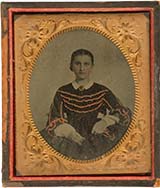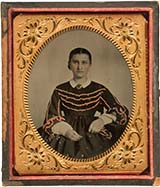Cleaning Old Photographs
Cleaning 19th century photos is to be avoided in some cases and approached with utmost care in others. Processes are different for each type of photograph.
Daguerreotypes
The amateur collector should avoid cleaning daguerreotype plate. PhotoTree has successfully restored (cleaned) daguerreotype with amazing success - with lasting results.
Frequently the daguerreotype just needs to be removed from the case and the glass cleaned. The surface of the plate may be bathed in distilled water to remove physical dust particles.
Ambrotypes
Ambrotypes have their own challenges, and can be damaged more easily than daguerreotypes. They are susceptible to scratching, but the image surface can also be damaged (dissolved) by contact with water or other liquids.
The ambrotype image was developed directly on glass. Great care should be taken to determine where the image is.
The ambrotype may consist of two separate plates of glass: a cover glass and the glass with the image on it. Or the photograph may consist of two plates of glass glued together.
-
If there are two separate plates of glass, you can easily determine which one has the image, but you need to determine which side of the glass the image is on.
-
If the photographer used a black lacquer to darken the glass, the image is on the other side of it.
-
If the photographer used a black cloth or paper, the image should be on the other side of this, but not always. Sometimes the photographer tinted a picture, most often the cheeks. But the tint may have been placed directly on the image, then the image was inserted into the case image side down. This let the tinting become appear more natural and smooth. Otherwise it sometimes looked like a clown's cheeks when viewed directly.
Either way the single-glass image probably should not e cleaned. If a double-glued glass is used, the image is sandwiched between the glass and somewhat protected. NOTE: Do not attempt to separate the two pieces of glass, the image will probably be destroyed by some pieces sticking to one glass, other pieces to the other glass.
However, if the viewing side glass is very dirty, you can clean it carefully. A safe technique employed is using cotton tip swabs, and dipping them in alcohol or spraying them with computer screen cleaner. Make sure they are not dripping or extremely saturated. These substances will not cleaning residue like a household cleaner. Be careful to not clean the edges as some of the cleaning fluid may leach into the image.
Clean the case, mat, and preserver with a soft brush and/or compressed air.
Tintypes
Treatment of tintypes is similar to ambrotypes, except it is obvious where the image is. DO NOT brush the image, it scratches easily. Use compressed air. If the tintype is in a case, clean it as described above. As usual, always handle images by the edges.
Vintage Cartes de Visite and Cabinet Cards
The CDV and its younger cousin the cabinet card are extremely allergic to liquids. Keep them away. Compressed air is the primary method of cleaning the image, though they can withstand brushing with a very soft brush - camera lens brush is the best.
Note: Test brush a portion along the edge of the photograph first, and examine that area closing in good light to detect any brush streaks. If you see any, do not proceed. |
|
General Cleaning Tips
Compressed Air
Canned air sometimes appears to spray moisture. This is actually condensation of room air, particularly if the humidity is high. Canned air is not even air, but compressed dry solvents, there is no moisture in the can. Test spray away from the image, on your arm for example, to detect if moisture or condensation develops. Do not use at this time on the images if moisture is evident.
Take care to not blow the air to closely or forcefully on ambrotypes and tintypes. The image emulsion sits on top of the glass or iron, and can actually flake off, or be blow off. Gently use the compressed air to remove surface dust.
Use Gloves
While cleaning photographs, you will be handling them quite a bit. White cotton gloves are a good investment in protecting your photographs.
Cleaning The Glass
If the glass can be safely removed from a daguerreotype, ambrotype, or tintype, cleaning it may improve the image dramatically.
Once removed from the case and image, the glass can be cleaned in hot soapy water.
A soft toothbrush works as a good scrubbing tool. Tap water can be used, however once cleaning is complete rinse the glass thoroughly with distilled water. This will help wash away any harmful impurities.
Further ensuring cleanliness and avoiding spots, rinse the glass in alcohol. This forces the water off the glass. Light patting with a clean cloth removes most of the alcohol, then using a blow drier, make sure all the alcohol has evaporated and the glass is dry. Handle the glass only by the edges throughout the process to prevent fingerprints.
 
Before and after glass cleaning (ca 1861 Ambrotype) |
|
Removed from the case, this glass reveals heavy soiling on both sides.
|
|
|
|